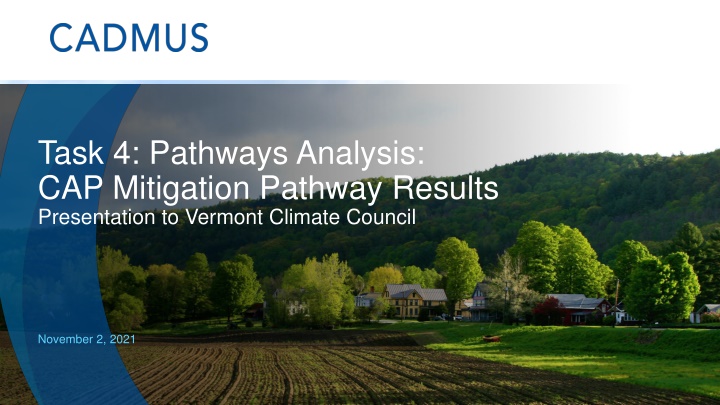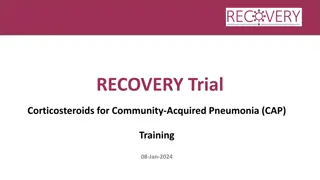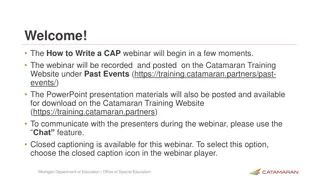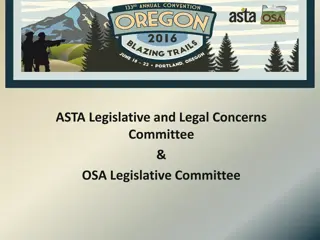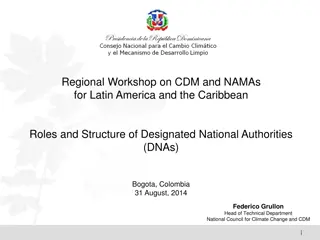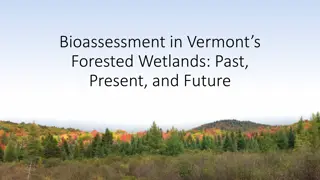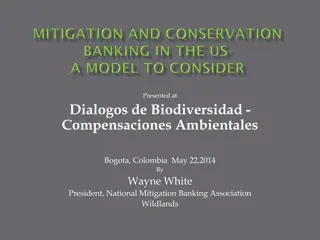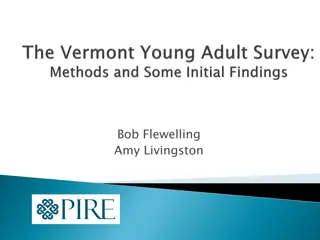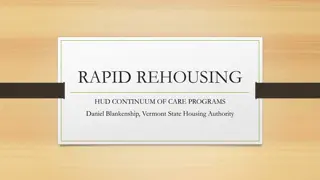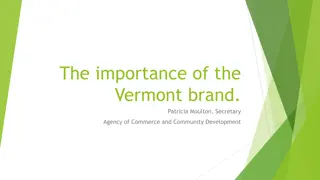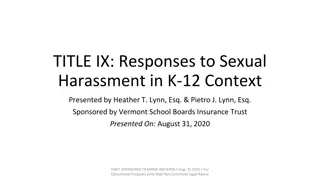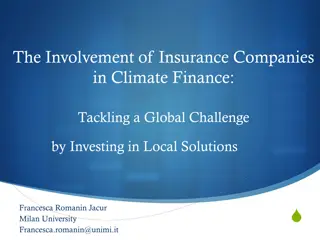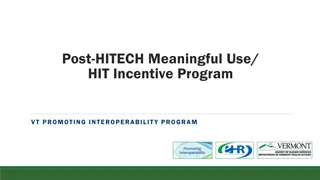Vermont Climate Council CAP Mitigation Pathway Analysis Results Presentation
The presentation to the Vermont Climate Council on November 2, 2021, showcases the CAP Mitigation Pathway Sector Analysis, Economic Results Comparison, Pathways Sensitivities, and more. It details the pathways analysis built upon State and Stockholm Environment Institute's work, outlining initial recommendations, sectoral impacts, emission reduction strategies, and pathways for 2025, 2030, and 2050. The focus is on developing immediate, short-term, and long-term policies and programs to meet reduction targets and achieve the GWSA targets.
Download Presentation

Please find below an Image/Link to download the presentation.
The content on the website is provided AS IS for your information and personal use only. It may not be sold, licensed, or shared on other websites without obtaining consent from the author.If you encounter any issues during the download, it is possible that the publisher has removed the file from their server.
You are allowed to download the files provided on this website for personal or commercial use, subject to the condition that they are used lawfully. All files are the property of their respective owners.
The content on the website is provided AS IS for your information and personal use only. It may not be sold, licensed, or shared on other websites without obtaining consent from the author.
E N D
Presentation Transcript
Task 4: Pathways Analysis: CAP Mitigation Pathway Results Presentation to Vermont Climate Council November 2, 2021
Agenda CAP Mitigation Pathway Sector Analysis By Time Period Transportation Buildings Non-Energy Electricity Economic Results Comparison Pathways Sensitivities Questions and Discussion 2
Pathways Analysis Build upon analyses completed by the State and Stockholm Environment Institute to deliver: Task 4a: Initial Pathways Analysis (Sept. 30) Recommendations and Excel table: Sectoral, jurisdictional and existing climate initiatives Impact of the VCC recommended strategies on emissions reductions Preliminary 2025, 2030 and 2050 pathway recommendations and corresponding LEAP inputs Task 4b: Draft and Final Pathways Report and Executive Summary (Nov. 15) 2025 Pathway: Immediate and short-term policies, programs, and initiatives to meet reduction targets. 2030 Pathway: Additional policies, programs, and initiatives to be advanced this decade to meet reduction targets. 2050 Pathway: Strategic framework for additional activities necessary to achieve 2050 emissions targets. Deliverables 50-page report, 10-page Executive Summary 3
Pathways Terminology Climate Action Plan 2025 GWSA Target 2030 GWSA Target 2050 GWSA target 2020 Actions/Activity Activities or benchmarks e.g. 120,000 Housing Units Weatherized, 60,000 EVs, Pathways CAP Mitigation Scenario, Biofuels Focused, Local Electricity. Strategies e.g. Weatherization at Scale, ICE Phase Out, Advanced Heat Pumps, ODS Substitutes. Policies/Programs a Policy or Program Clean Heat Standard, 100% Renewable Energy Standard, Replace Your Ride. 4
CAP Mitigation Pathway and GWSA Targets 7,380 2025 GWSA target 5,180 2030 GWSA target 1,730 2050 GWSA target 6
Sector Modeling Transportation
Transport Sector CAP Mitigation Pathway Sector Emission Reductions: 15% by 2025 36% by 2030 89% by 2050 Primarily from Electric Vehicles Increased efficiency Cleaner fuel Other contributors Biofuels VMT reductions 8
Transport Sector CAP Mitigation Pathway By 2025: 43,400 EVs, increase of more than 39,000 over today. By 2025 EVs are almost 40% share of light duty vehicle sales. All major automakers have invested in EV technology and are expected to release additional EV models in the next three years, including new electric pickup trucks and sports utility vehicles, which are currently under-represented in the vehicle market. Precedes California Advanced Clean Cars II which would require manufacturers to deliver increasing share of Light Duty Evs in 2026, ramping up to 100% in 2035. 10
Transport Sector CAP Mitigation Pathway By 2030: 166,000 EVs, almost 4x greater than baseline projection of 43,000. By 2030 EVs account for 29% of vehicle miles travelled. Vehicle mile demand management initiatives result in 3.5% reduction in vehicle miles travelled compared to baseline. 50% of EV charging is managed to reduce peak impacts. Sales of new ICE vehicles phased out by 2033. 11
Transport Sector CAP Mitigation Pathway By 2025 and 2030: Shift in the technologies and markets is underway and revolutionary. Incentives and extensive public messaging and promotion to support rapid adoption. Particular attention to equity and reducing transportation energy burden. Participation with regional and national initiatives necessary but not likely sufficient. Initiatives to include managed charging and smart rate designs. Revenue options include Transportation Climate Initiative and Federal funds. All said and done, required pace of change is daunting but essential component of meeting the Climate Imperative Challenge. 12
Transport: Pathway Key Policies, Strategies & Actions Supporting the CAP Mitigation Pathway: Transportation Climate Initiative, and associated initiatives such as: Replace your Ride Transit Smart growth and other Transportation Demand Management, and Feebates Managed Charging Source TCI-P updates program webinar, March 2021 13
Sector Modeling Buildings
Buildings Sector CAP Mitigation Pathway Emissions reductions from 2020 to 2030 45%, and by 2050 80%. ~55% from residential, 33% Commercial, 12% Industrial 15
Buildings Sector CAP Mitigation Pathway Residential, primarily space heating Commercial, primarily space heating Heat pumps, shell efficiency. Heat pumps, phase out of water and cooking fossil Phase out of fossil cooking and water heating Blended heating oil and increased RNG blending Blended heating oil and increased RNG blending 16
Residential Buildings CAP Mitigation Pathway By 2025: Nearly 80,000 heat pumps, almost 50,000 above baseline. More than 60,000 heat pump water heaters. More than 60,000 Weatherized units - more than 2x baseline. 1.9 Trillion Btu s of biofuels, equivalent to meeting the needs of almost 20,000 average single-family units. 17
Buildings CAP Mitigation Pathway By 2025: Support income qualified heat pumps and weatherization. Heat pumps gaining rapid market share, more than 11,000 in 2020, but continued rapid adoption required. Workforce development essential to scale activity in building sector wages and training. Coaching and financing important supports. 18
Buildings CAP Mitigation Pathway By 2030: More than 142,000 residential heat pumps an increase of 84,000 above baseline. Phasing out of water heating and cooking underway. Weatherization of 120,000 units. Biofuels increasing contribution to reductions. Cumulative Emissions Reduction by Element Compared to Baseline 19
Residential Buildings Weatherization and Heat Pumps CAP Mitigation Pathway 20
Commercial Buildings CAP Mitigation Pathway Commercial Emissions by End Use Commercial Emissions by Heating System Type 21
Industry CAP Mitigation Pathway Industry Final Energy Demand Biogas and Biodiesel All Sectors 22
Buildings CAP Mitigation Pathway By 2050: Modernized building infrastructure. Electrified end uses Grid interactive and connected buildings to coordinate multiple loads across multiple sites. Storage for resilience. Reduced energy burdens for buildings. Greater on-site generation. Discounted Social Costs by Element Compared to Baseline 23
CAP Mitigation Pathway Buildings: Key Policies, Strategies & Actions CAP Mitigation Pathway supported by: Clean Heat Standard, Rental Efficiency Initiative, Weatherization at scale, Fossil cooking and water heating phase out, Net zero new construction standards for residential and commercial, Increased demand response and coordinated load management 24
Sector Modeling Non-Energy
Non-Energy Sector CAP Mitigation Pathway Emissions reductions from 2020 to 2030 32%, and by 2050 53%. ~2/3rds of the reductions are from Agriculture, 1/3rd Industrial Processes 26
CAP Mitigation Non-Energy Agriculture By 2030: Adoption of alternative feed practices to reduce emissions from enteric fermentation. Adoption of manure management practices. Increased sequestration by agricultural soils. Value of reduced emissions of 350,000 Metric Tonnes CO2e by 2030 has social cost of carbon value of more than $40 million. Increased research on feasibility, adoption and impacts all required. 27
CAP Mitigation Non-Energy Industrial Processes By 2030: The reduction in emissions from ODS substitutes are in line with Vermont s Hydrofluorocarbons (HFC) Rule, which mandates a phase down of the use of HFCs to meet the goal of a 40% reduction from the 2013 level of use by 2030. Federal initiative to phase down HFC production and consumption by 85% over next 15 years. Refrigerant management, leak reduction and alternative refrigerants Modest (8% by 2030) reduction for semi-conductor manufacturing based on historic trend. 28
CAP Mitigation Non-Energy 2050 Net Zero By 2050: Sequestration from Land Use Change and Forests is estimated based on Cadmus Team/UVM Carbon Budget Report Lower starting level of sequestration based on Carbon Budget Research. Steady linear decline in sequestration based on historic trends Necessary to reduce loss of sequestration and maintain at or above projected 2035 level to attain net zero target. Natural and Working Lands Need Focus to Meet Net Zero! 29
Non-Energy Pathway Key Policies, Strategies & Actions CAP Mitigation Pathway reflects new findings from the Carbon Budget Report. CAP Mitigation Pathway supported by: Practices to reduce enteric fermentation emissions, Manure management initiative, Practices to increase soil carbon sequestration, ODS substitutes including refrigerant management, Target reductions for semi-conductor manufacturing Research and actions to maintain sequestration to achieve net zero in 2050. 30
Sector Modeling Electricity
Electricity Sector CAP Mitigation Pathway Significant increase in electricity demand to meet the electrification demands from transportation and buildings. Electric Generation mix continues trend toward renewables, and 100% Renewable Energy Standard by 2050. Load management, flexible and coordinated loads and storage all key strategies. 32
Electricity Sector CAP Mitigation Pathway By 2025: Increase of electric demand over baseline of 796,000 MWh. Electricity meeting 20% of final demands by 2025, reaching more than 55% by 2050 Potential upgrades to serve close to 80,000 heat pumps, 60,000 heat pump water heaters, and more than 40,000 EVs. Equity and access to electrification for all. Continued growth of customer sited solar, 600 GWh by 2025. 33
Electricity CAP Mitigation Pathway By 2030: Peak power requirements increase by more than 40% over baseline. Offshore wind providing more than 2,000 GWh, Onshore wind 1,200 GWh. 50% of EV charging is managed. 34
Electricity CAP Mitigation Pathway By 2050: 8,000 GWh of export or curtailed power in order to meet demand in all time slices. Opportunities for coordinated and flexible load management to reduce the over-generation. May also provide strategic electrification for industry. 35
Electricity Pathway Key Policies, Strategies & Actions CAP Mitigation Pathway supported by: Expansion of renewable energy standard to reach 100% by 2050 Investigation of demand response, flexible load management, and storage to address curtailment Potential for additional strategic electrification in industry Consideration of Local renewables focus 36
Economic: Early Demand Investments, Later Transformation 39
Economic: Net costs of $22 to $6/tonne CO2e Economic Summary: Cumulative Costs-Benefits 2015-2050, Relative to Baseline Discounted 2% to year 2019, Units Billion 2019 US Dollars 40
Economic: All Pathways Strong Net Economic Benefits including Social Cost of Greenhouse Gases 41
Sensitivities: Hydro Quebec Emissions Based on Science and Data Subcommittee recommendation and citation from a literature reference by A. Levasseur. Net biogenic emissions values of 16.5 gCO2/kWh, and 0.29gCH4/kWh included in a sensitivity for Large Hydro emissions Cumulative difference of 250,000 metric tonnes CO2e by 2050. 42
Sensitivities: Biogenic CO2 Based on Science and Data Subcommittee recommendation report on Biogenic C02 for CAP mitigation Pathway. Comparative CO2 emissions (biogenic and nonbiogenic) Net cumulative reductions decrease from 77 million tonnes if biogenic is not counted to 74 million metric tonnes if it is included. 250.0 Cumulative million metric tonnes CO2 200.0 150.0 100.0 50.0 - 2020 2025 2030 2035 2040 2045 2050 CAP Mitigation Pathway Baseline 43
